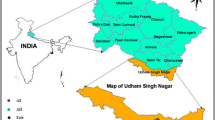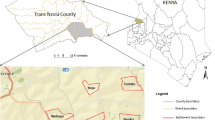Abstract
Farmers in the highlands of Ethiopia often plant Eucalyptus on their farmlands. However, growing Eucalyptus, especially on farmlands suitable for crop production has become a great concern due to its alleged long-term site effects. Our study was conducted at Koga watershed, Mecha District, northwestern Ethiopia to investigate whether croplands afforested with Eucalyptus camaldulensis Dehnh. can be restored for annual crop production after tree harvest. We compared growth and yield of two agricultural crops, barley (Hordeum vulgare L.) and finger millet (Eleusine coracana (L.) Gaertn.), grown in clear-felled stands of E. camaldulensis and continuously cultivated croplands at twelve paired farmlands under a conventional farming system. Plant height and dry matter production were evaluated as indices of crop growth, while grain weight was evaluated as an index of crop yield. Crop growth and yield measurements averaged over all farmlands differed between land-use types. For both crops, plants grown on clear-felled stands were taller than on croplands. Dry matter production and yield were also significantly greater in crops cultivated on clear-felled stands. Cropland aboveground and belowground dry matter productions were lower by 31.8 and 25.4% for barley and 32.8% and 37% for finger millet, respectively. Clear-felled stands gave an average yield of 2.91 t·ha−1 for barley and 3.27 t·ha−1 for finger millet while cropland gave a yield of 1.97 and 2.31 t·ha−1 for barley and finger millet, respectively. Farmers also responded that farm plots on former eucalypt plantations showed greater crop growth and yield than did continuously cultivated croplands. Farmers perceived that Eucalyptus plantations improved soil fertility and they preferred clear-felled stands for crop production and wished to plant Eucalyptus on their farmlands. Our results suggest that conversion of agricultural lands to Eucalyptus plantations can increase post-felling yields of cereal crops.
Similar content being viewed by others
References
Adimassu Z, Kessler A, Yirga C, Stroosnijder L. 2010. Mismatches between farmers and experts on Eucalyptus in Meskan woreda, Ethiopia. In: L Gil, T Wubalem, E Tolosana and R López (eds), Eucalyptus Species Management, History, Status and Trends in Ethiopia. Addis Ababa: ETH-CANA publishing company, pp.146–159.
Ahmed R, Hoque R, Hossain MK. 2008. Allelopathic effects of leaf litters of Eucalyptus camaldulensis on some forest and agricultural crops. Journal of Forestry Research, 19(1): 19–24.
Alem S, Woldemariam T, Jindrich PJ. 2010. Evaluation of soil nutrients under Eucalyptus grandis plantation and adjacent sub-montane rain forest. Journal of Forestry Research, 21(4): 457–460.
Calfapietra C, Gielen B, Karnosky D, Ceulemans R, Mugnozza GS. 2010. Response and potential of agroforestry crops under global change. Environmental pollution, 158: 1095–1104.
Chanie T, Collick AS, Adgo E, Lehmann CJ, Steenhuis TS. 2013. Eco-hydrological impacts of Eucalyptus in the semi-humid Ethiopian Highlands: the Lake Tana Plain. Journal of Hydrology and Hydromechanics, 61(1): 21–29.
El-Khawas SA, Shehata MM. 2005. The Allelopathic Potentialities of Acacia nilotica and Eucalyptus rostrata on Monocot (Zea mays L.) and Dicot (Phaseolus vulgaris L.) plants. Biotechnology, 4(1): 23–34.
FAO. 2001. World Soil Resources Reports 94, Rome: FAO Publishing and Multimedia Service, pp. 171–176.
Forrester DI, Bauhus J, Cowie AL, Vanclay JK. 2006. Mixed-species plantations of Eucalyptus with nitrogen-fixing trees: a review. Forest Ecology and Management, 233: 211–230.
Gindaba J. 2003. Water and nutrient relations of selected tree species of Ethiopia. PhD dissertation. Department of forest science, Stellenbosch University, South Africa, p. 180.
Gindaba J. 2006. Overview of water and nutrient relations of Eucalyptus and deciduous tree species and implications for their use in land rehabilitation. Journal of the Dry lands, 1(1):15–25.
Guo LB, Sim RH, Horne P. 2006. Biomass production and nutrient cycling in Eucalyptus short rotation energy forests in New Zealand: litter fall and nutrient return. Biomass and Bioenergy, 30(5): 393–404.
Hailu Z. 2002. Ecological impact evaluation of Eucalyptus plantations in comparison with agricultural and grazing land use types in the highlands of Ethiopia. PhD dissertation. Vienna University of Agricultural Sciences, Vienna, p. 271.
Jagger P, Pender J. 2003. The role of trees for sustainable management of less-favored lands: the case of Eucalyptus in Ethiopia. Forest Policy and Economics, 5(1): 83–95.
Jenbere D, Lemenih M, Kassa H. 2012. Expansion of eucalypt farm forestry and its determinants in Arsi Negelle District, south central Ethiopia. Small-scale Forestry, 11(3): 389–405.
Kelemu K, Tadesse W. 2010. Analysis of Eucalyptus role in the livelihoods of rural households. In: L Gil, T Wubalem, E Tolosana and R López (eds), Eucalyptus Species Management, History, Status and Trends in Ethiopia. Addis Ababa: ETH-CANA publishing company, pp. 53–61.
Kidanu S, Mamo T, Stroosnijder L. 2004. Eucalyptus-wheat interaction on Ethiopian Nitisols. Agricultural Systems, 80(2): 151–170.
Kidanu S, Mamo T, Stroosnijder L. 2005. Biomass production of Eucalyptus boundary plantations and their effect on crop productivity on Ethiopian highland Vertisols. Agroforestry Systems, 63(3):281–290.
Lemenih M, Olsson M, Karltun E. 2004. Comparison of soil attributes under Cupressus lusitanica and Eucalyptus saligna established on abandoned farmlands with continuously cropped farmlands and natural forest in Ethiopia. Forest Ecology and Management, 195: 57–67.
Lemenih M, Teketay D. 2004. The role of plantation forests in fostering restoration of native flora and fauna at degraded sites in Ethiopia. Ethiopian Journal of Biological Sciences, 3(1): 81–111.
Lemenih M. 2010. Growing Eucalyptus by smallholder farmers in Ethiopia. In: L Gil, T Wubalem, E Tolosana and R López (eds), Eucalyptus Species Management, History, Status and Trends in Ethiopia. Addis Ababa: ETH-CANA publishing company, pp. 91–103.
Lemma B, Kleja DB, Nilsson I, Olsson M. 2006. Soil carbon sequestration under different exotic tree species in the southwestern highlands of Ethiopia. Geoderma, 136(3): 886–898.
Lisanework N, Michelsen A. 1993. Allelopathy in agroforestry systems — the effects of leaf extracts of Cupressus lusitanica and three Eucalyptus species on four Ethiopian crops. Agroforestry Systems, 21(1): 63–74.
Michelsen A, Lisanework N, Friis I. 1993. Impacts of tree plantations in the Ethiopian highland on soil fertility, shoot and root growth, nutrient utilization and mycorrhizal colonization. Forest Ecology and Management, 61: 299–324.
Pohjonen V, Pukkala T. 1990. Eucalyptus globulus in Ethiopian forestry. Forest Ecology and Management, 36: 19–31.
Prasad JVNS, Srinivas K, Rao CS, Ramesh C, Venkatravamma K, Venkateswarlu B. 2012. Biomass productivity and carbon stocks of farm forestry and agroforestry systems of Leucaena and Eucalyptus in Andhra Pradesh, India. Current Science, 103(5): 536–540.
Tchienkoua M, Zech W. 2004. Organic carbon and plant nutrient dynamics under three land uses in the highlands of West Cameroon. Agriculture, Ecosystems and Environment, 104: 673–679.
Zegeye H. 2010. Environmental and socioeconomic implications of Eucalyptus in Ethiopia. In: L Gil, T Wubalem, E Tolosana and R López (eds), Eucalyptus Species Management, History, Status and Trends in Ethiopia. Addis Ababa: ETH-CANA publishing company, p.184–205.
Author information
Authors and Affiliations
Corresponding author
Additional information
Project funding: This work was financially supported by Bahir Dar University Research and Community Service.
Rights and permissions
About this article
Cite this article
Tadele, D., Teketay, D. Growth and yield of two grain crops on sites former covered with eucalypt plantations in Koga Watershed, northwestern Ethiopia. Journal of Forestry Research 25, 935–940 (2014). https://doi.org/10.1007/s11676-014-0483-9
Received:
Accepted:
Published:
Issue Date:
DOI: https://doi.org/10.1007/s11676-014-0483-9




